Text
Fiona Shaw on The Testament of Mary
Actress Fiona Shaw discusses her collaboration with director Deborah Warner to transform Colm Tóibín’s novel into a mesmerising performance that speaks to a universal audience.

I was surprised to be asked to play the Virgin Mary. Like a strange Annunciation, the offer came not from an angel holding a lily but from a playwright (Colm Tóibín) holding a glass of wine! Understandably, I felt unprepared and an unlikely choice. Images from my childhood reinforced this wariness – the pale blue, washed-out figure of a woman who represented passive, bland, characterless goodness. In the New Testament she speaks only twice, and even the Virgin of later life, before her Assumption into heaven, is presented as a beatified, worn woman, a gold halo round her head, surrounded by the protective concern of the men who really mattered to the story – the Apostles.
Deborah (Warner) and I began working on this unusual piece of theatre writing, offered without dramatic structure but accompanied by a novel to be sifted and plundered for clues and details. The Testament of Mary sets two hares running in the mind – one religious, one secular. The story has been absorbed by us all – Jewish, Christian, Muslim and nonbeliever alike – and this story runs in parallel, and sometimes across the tracks, of the one we are telling.
The audience plays a part in this drama as the viewer comes armed with the image of the Virgin Mary as a beatified suffering mother, whose son, Jesus of Nazareth, became the axis of history in religion and Western thought for the next 2,000 years. His mother is delivered to us in images that dominate Western art and culture not only as Queen of Heaven, but also as the glorified queen of all virtue and goodness on earth.
In our play we offer an ordinary woman – a mother dealing retrospectively with the death of her radical son. Her anonymity is disrupted by the need of her son’s followers to spin his story to make significance out of his life and his death by crucifixion. This woman is merely a victim of the politics of her age. She talks pragmatically about the new Roman coins coming into use and the need for young men to move to the cities for work. This is perhaps the lonely experience of women all over the world who endure their sons’ drift away from home. Sons who become unrecognisable from the children they have loved and comforted. We see her disappointment at her once shy child’s growing self-importance, his rampant public profile and her natural yet pitiful attempt to save him from himself by turning up at his cousin’s wedding at Cana, to warn him of the danger he is in. We witness her huge failure of nerve as she observes his torture and death. In this story the famous son rejects his mother and she returns home to watch helplessly as the tragedy of his life unfolds. This woman is not a woman of virtue, but an opinionated, private individual. We meet her in the aftermath of terrifying events. Once the drama is over, the trauma of memory remains and a life lived alone in exile.
To my surprise, as we rehearsed this familiar yet unfamiliar tale, and indeed in the playing of it in New York last year, we found a sort of spirituality that had nothing to do with religion or received morality. In every attempt to avoid the spiritual, we met it head on – the deep, unowned divinity of being human. The story of this woman is as individual as the story of everyone in the audience. Each of us has our own private sorrow in relationship to our children, and it is that which makes us both universally bonded and universally alone.
Originally published in the May 2014 Guide
The Testament of Mary by Colm Tóibín will be performed 1–25 May 2014.
Photo: Brigitte Lacombe
#Barbican Theatre#Fiona Shaw#Deborah Warner#Theatre#The Testament of Mary#Colm Tóibín#Literature#Writing
15 notes
·
View notes
Text
Skydweller: Top of the Tower
Filmed over the course of one day from the top of Cromwell Tower, one of three residential towers in the Barbican estate, Skydweller combines over 5,000 photographs in a stunning timelapse of the view across London.
With specially composed music by Tom Rosenthal and poetry by artist, poet and Barbican host, Paul Haworth, this short film offers a unique view of our bustling capital and its residents from the calm above.

View more photos from Skydweller on the Barbican Flickr.
Skydweller was commissioned to celebrate the launch of our Constructing Worlds season, encompassing a major exhibition in the Barbican Art Gallery, Constructing Worlds: Photography and Architecture in the Modern Age, a new commission by LA artist Walead Beshty in The Curve and a specially curated film season, from September.
#Barbican Gallery#Barbican Centre#Barbican Estate#Photography#Timelapse#Poetry#Music#London#England#City#Urban#Urban Wandering#Barbican Tower
8 notes
·
View notes
Text
Royal Concertgebouw Orchestra Amsterdam present Bruckner
This April, we journey to the sublime and experience the epic force of Bruckner’s most powerful and spiritually uplifting symphonies as the Royal Concertegbouw Orchestra Amsterdam, led by Mariss Jansons, return for their second International Associate residency.

Ahead of their residency, broadcaster James Jolly spoke to Mariss Jansons about the Orchestra and their forthcoming concerts:
Writer and BBC Radio 3 presenter, Stephen Johnson on Brucker's symphonies:
‘Bruckner likes to take his time: he builds slowly. The moment of revelation does come, eventually, but you have to wait for it. Sometimes Bruckner is like a walking-tour guide who stops from time to time to consult his map, or to point out some unexpected entrancing vista, but who always gets to his destination. And the scenery he uncovers is magnificent, unlike anything revealed by anybody else.’
Originally published in the April 2014 Guide.
Royal Concertgebouw Orchestra Amsterdam will be in residence from 3–5 April 2014. Browse the season online.
#Barbican#Barbican Classical Music#Royal Concertgebouw Orchestra Amsterdam#Orchestra#Mariss Jansons#Bruckner#Podcast
2 notes
·
View notes
Text
Google DevArt: when art and technology collide
Earlier this year, we announced our upcoming exhibition, Digital Revolution (3 July–14 September), a celebration of the digital world and its impact on the arts which will see the Barbican filled with immersive and interactive works from a range of artists, filmmakers, architects, designers, musicians and game developers. What do they all have in common? They are all pushing the boundaries of their fields using digital media.
In collaboration with Google, we announced an exciting collaboration, DevArt, to commission a developer to create a new digital art installation which would be displayed alongside some of the world’s best interactive artists at Digital Revolution. With less than a week to go before applications close on Friday 28 March, there is still time to submit your work to be in with the chance to see your work at the Barbican in Digital Revolution before the exhibition’s global tour.
How do you create art from code? As part of the DevArt section in Digital Revolution, Google commissioned three artists, Karsten Schmidt, Zach Lieberman, and duo Varvara Guljajeva and Mar Canet to create one, all-new installation. Follow their journey from concept and early sketches to their finished pieces on their Project Pages where they’ll be sharing their creative processes and offer a unique look into their palette of modern technologies including Google APIs, products and services.

Because who needs paper when we you have code…
Submit your entry to Google DevArt by Friday 28 March 2014, 18:00 GMT.
Need some inspiration? Browse some of the DevArt Featured Projects.
Digital Revolution takes place at the Barbican from 3 July–14 September 2014. Tickets are available now.
#Google#Digital Revolution#Digital#Technology#Code#HTML#API#Inspiration#Installation#Barbican Art Gallery#Video#Gaming
2 notes
·
View notes
Text
Toni Servillo on ‘Inner Voices’
One of the most distinguished actors of his generation, Naples-born Toni Servillo returns to his roots in Neapolitan theatre with his new production of Eduardo De Filippo’s Inner Voices. He talks to Pasquale Iannone about theatre, film and his continuing fascination with the work of De Filippo.

In December 2013, Toni Servillo took to the stage at the Haus der Berliner Festspiele to receive the award for Best Actor at the European Film Awards for his extraordinary performance in Paolo Sorrentino’s The Great Beauty. He barely had time to catch his breath before making his way back to Bergamo to rejoin the cast and crew of Inner Voices.
It’s been that kind of whirlwind year for Servillo, but he wouldn’t have had it any other way. Theatre is the 54-year-old’s first love and he has said that it always keeps his ‘feet on the ground’.
I asked him whether this had been particularly true during recent months. ‘We were perfoming Inner Voices at the Teatro Donizetti in Bergamo and the management agreed to move the Saturday evening performance to Sunday so I could attend the award ceremony. Barely 24 hours after Berlin, I was backstage in Bergamo waiting to perform in front of more than a thousand spectators, with the usual feeling of trepidation and responsibility. When a performance doesn’t go the way it should, it’s always a great frustration, and keeping this in mind – making sure the performance is the best that it can be – makes sure that you never get carried away with notions of success.’
The last time Servillo acted in a Neapolitan play, it was in Eduardo De Filippo’s Saturday, Sunday and Monday in 2002, a production he also directed. Servillo returns to De Filippo with Inner Voices, the story of a man who, after accusing his neighbours of murder, realises it was only a dream, but is powerless to stop the ensuing recrimination and suspicion. Could it be said that it’s as relevant today as it was when it was written in 1948? ‘It’s a story that in a way reflects the uncertainty, the sense of disorientation that we’re living through now; the bitter loss of faith – by faith, I mean believing in something completely. But above all, it’s the feeling that criminality (both legal and moral) has almost been legitimised. These are themes that Eduardo deals with in a very clear and precise way in an atmosphere suspended between reality and fantasy, and I think that’s why modern audiences find it so compelling.’
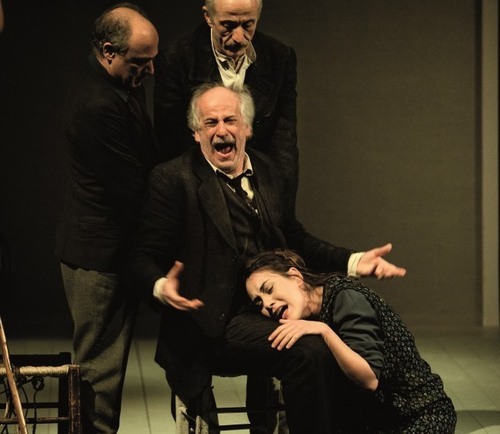
The metaphysical qualities of Inner Voices have in the past led critics to make comparisons with Luigi Pirandello, but Servillo has a more nuanced reading. ‘There’s no doubt that Pirandello was a big influence on Eduardo and that, like Pirandello, Eduardo was interested in blurring the lines between reality and the world of dreams, but I think that Eduardo’s characters are far more flesh and bone. There’s also – in this play, especially – a strong comic element, a lightness of touch that’s far removed from any kind of dry formalism.’
More than thirty years after Sir Ralph Richardson’s famous (final) performance in the lead role, London audiences will once again be able to see Inner Voices brought to life by a fine European actor at the height of his powers.
Pasquale Iannone is a Lecturer in Film Studies and a writer and broadcaster whose work includes contributions to Sight & Sound and BBC Radio.
Inner Voices (Le voci di dentro) by Eduardo De Filippo is performed in the Theatre from 26–29 March 2014.
Originally published in the April 2014 Guide.
Photo: Fabio Esposito
2 notes
·
View notes
Photo
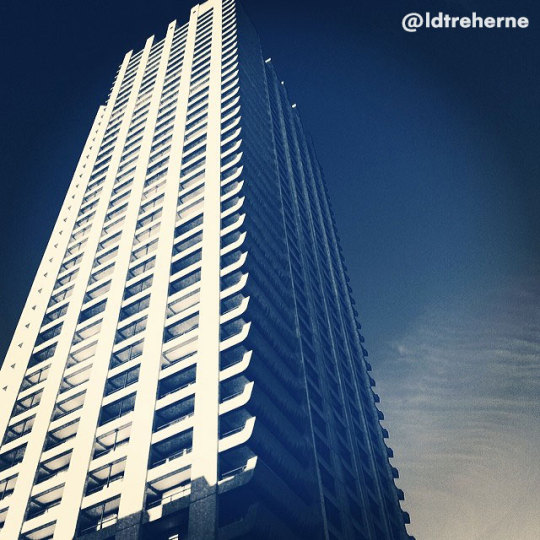

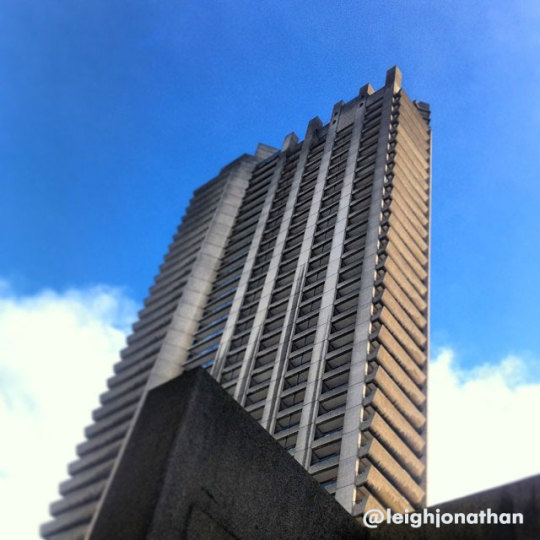

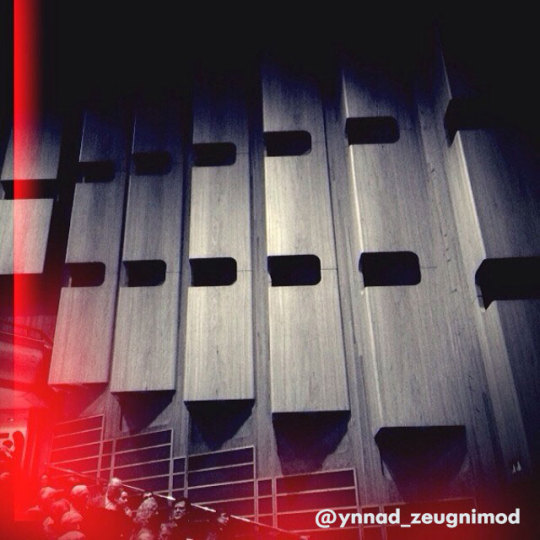



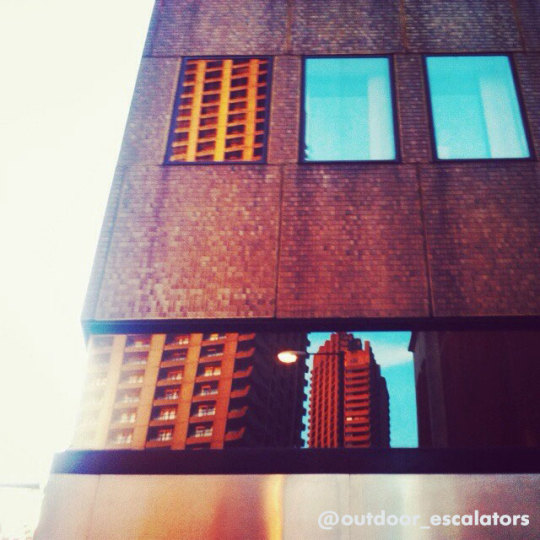

Your Barbican: February
We love seeing how you capture the many views of the Barbican. In our new feature, Your Barbican, we've chosen some of our favourites from your photographs from Instagram.
Thank you to this month's top Barbican Instagrammers: colceon, jdonn, kurtvermeulen, leighjonathan, outdoor_escalators, riabhavnani, selimhaulu, ynnad_zeugnimod and ldtreherne.
Want to see yours on the blog next month? Make sure to tag @barbicancentre on Instagram.
11 notes
·
View notes
Photo
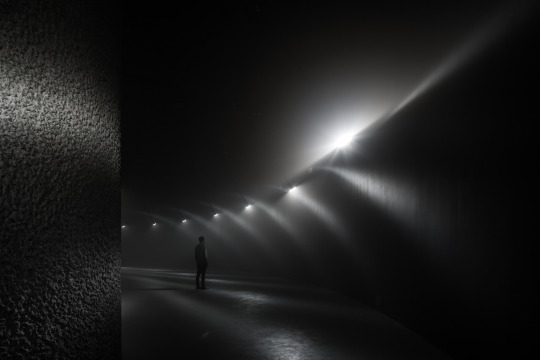
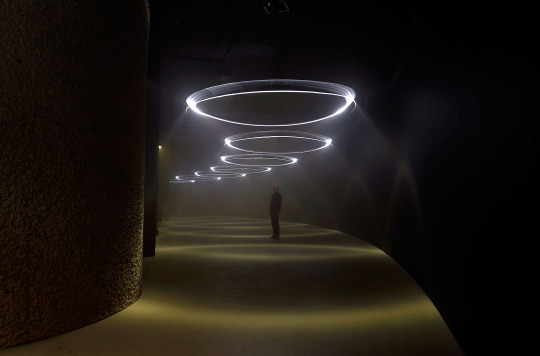

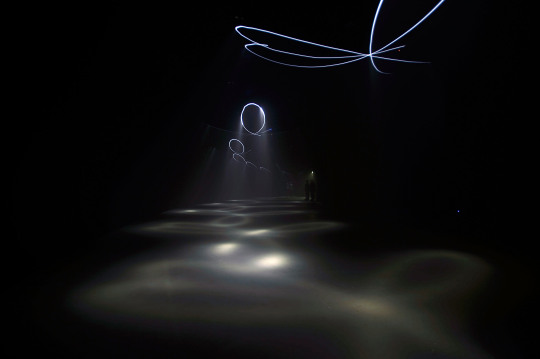



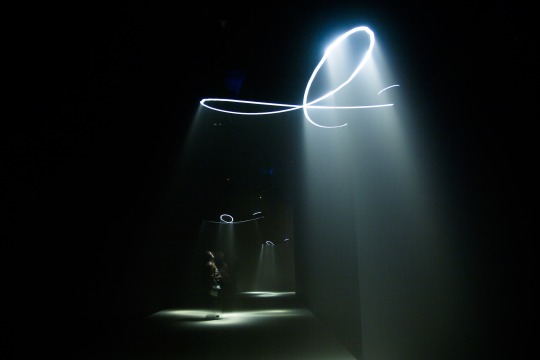
Follow the light...
United Visual Artists: Momentum is now open in The Curve until 1 June 2014.
#Barbican Art Gallery#Barbican Centre#Light#Installation#United Visual Artists#uvamomentum#Momentum#Photography#Photo#Design#Technology#Digital
34 notes
·
View notes
Text
United Visual Artists present Momentum
We speak to UVA about their carefully choreographed installation of light, sound and movement designed specially for the unique space of The Curve.

What inspired Momentum?
Momentum was inspired by scientific instruments like the Foucault pendulum, objects that visualise invisible forces at scales much larger than us. Momentum continues a path set out by our previous work, Chorus (2009), creating a spatial instrument to explore our notions of perception, physics and the relation between the two.
How does it work?
Momentum plays on our expectations of how objects behave in our world to create an experience that makes us question the way we perceive. The installation is made up of an array of pendulums that are suspended from the ceiling, allowing visitors to walk freely underneath. Without giving everything away, a lot of technology is working in the background to make the different mediums of physical movement, light and sound alter your perception of the gallery.
Your commissions seem to interact with different social concerns – like Origin in New York, or High Arctic in London. Does Momentum focus on anything in particular?
One of the main ideas fuelling this work is the concept of perception; how what you see is determined by what you have learned – in many respects. How things that don’t conform to our expectations make us feel uncomfortable and tend to be rejected. Momentum is meant as a metaphor for the way we process and filter information in general, but deals with more immediate information: that of how we perceive our surroundings.
What would you like the visitor to experience?
It’s hard to predict how people will individually experience Momentum, but we imagine their emotions will range from feeling ever so slightly strange to a more meditative experience. Momentum is not demanding its viewers to adapt any particular behaviour, but encourages them to walk freely within The Curve at their own pace. The experience will vary substantially according to the vantage point they choose. In addition, behind what you see in Momentum is a system running on algorithms, meaning that every few minutes a new pattern will emerge, evolving over time. Visitors are invited to come back during the course of the exhibition and re-examine the experience.
Will it be dark or will I be able to see?
While the overall light levels are pretty low, Momentum animates light in a way that will emit sufficient levels for anyone to walk comfortably. So the answer is: yes and no.

Can you tell us about the significance of sound in the installation?
Sound was an integral part of Momentum from its very conception, just as important as the physical movement and the light. All three aspects are orchestrated to generate the overall installation. Sound is an incredibly important medium when determining an object’s position, size and speed.
What excites you about the commission?
The commission offers a unique opportunity to respond to The Curve’s architecture and exhibit something to the Barbican’s diverse audience. As a project, it has been an exciting challenge for everyone involved, pushing the boundaries of many different disciplines.
What materials will you use to create the installation?
We are using steel and aluminium to create a custom mechanical assembly wired with custom electronics, a 3-D printed speaker chamber with driver and lensed LED. The installation is controlled by our d3 software, running modules specifically programmed for this project. Complicated as it is, Momentum is a result of thorough testing of all aspects using rapid prototyping techniques and experimenting with more than a few electronic and control solutions.
Your work seems to take a lot of influence from its environment. What particular characteristics of The Curve gallery will be drawn out?
The geometry of The Curve allows us to use it as a continuous canvas. The walls are where much of the action will take place, as light is projected and sound reflected off them. The space itself merges everything together.
How did you all meet?
The group has evolved over the years. UVA was founded in 2003 by Matt, Chris and Ash who met on a project that combined their individual expertise. Ever since, the team has grown to encompass an even greater eclectic assortment of talents.
United Visual Artists: Momentum opens 13 February – 1 June 2014 in The Curve. Entry is free.
Originally published in the February 2014 Guide.
#Barbican Art Gallery#United Visual Artists#Momentum#Installation#Exhibition#London#Art#Design#The Curve#Interview
1 note
·
View note
Text
What is a theatre concert?
Defying categorisation at all costs, Danish director Nikolaj Cederholm introduces his pioneering ‘theatre concert’, Mozart Undone, ahead of its riotous arrival in our Theatre this February…

“When we worked on our latest production in Norway, Theatre Concert Beethoven, our photographer said that his first experience of a theatre concert ‘was like going to Rome for the first time, or like arriving in a city I’d never been before’. That made me smile!
When we perform to brand new audiences, who have no idea what to expect from our shows, the reaction is usually quite similar. For the first fifteen minutes, there is an uncertain silence in the auditorium, as they work hard to fathom what they are experiencing. And then, at the twenty-minute mark, there is a shift: they suddenly get it.
The relief can be felt in their reaction: laughter, gasps, spontaneous applause. They think: ‘ok, it’s strange, but it’s funny; it’s different, but it’s good!’ They allow themselves to be seduced by this new experience, and by the end give us a standing ovation, sharing their enthusiasm and approval.
So, what is a theatre concert again? The recipe is simple: you take some music (it can even be very old music), chop it up, re-configure it, spice it, stretch it, sear it, and stitch it. Add some theatrical elements, some MTV, some aerial work or a cascade of water, some haute couture, new words if you want to, and there you go - you get a theatre concert!
The theatre concert story began with a conversation about musical theatre one spring in 1993. Our issue was this: we liked to work with music in theatre, but we found musicals boring and artificial. We didn’t want to make music that might simply underscore a plot point. For example in a musical there is often a song that nobody really likes but that has to be there so that you can understand the story.
We also found traditional rock concerts full of clichés: the hackneyed litany of ’Hello Stockholm! How ya feelin' tonight?’, ’Here's a song from our new album‘ or ’You might know this one’ followed by cries of ’Encore, encore!’. We were tired of the same old patterns, everything felt so predictable.
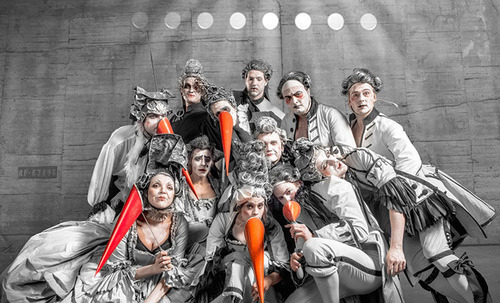
From this conversation sprang the idea of making an interpretation of the work of a rock band (in our case, the Danish group Gasolin'), just as theatres do Shakespeare and classical orchestras do Beethoven. To that end, we would take all the interesting genes from theatre history and cross-breed them with the rock concert. And what we got from this process was the theatre concert.
While it's true that music and theatre have often before bred new forms, this truly feels like untried territory, a fruitful new connection between the two. That's because we interpret the works of others not only in music, but also visually, in the action, in the movement, in the costumes, and in the stories we tell.
And think about how odd it is, when you go to see an opera, that the most expensive part of the production is hidden away in the pit? That's right, the orchestra is placed just out of sight of the audience, which is strange, since one of the big joys of live music is that you get the chance to witness these experts handle their instruments. I think that it's fundamentally pleasurable to watch musicians play.
That's why in a theatre concert the five or six-piece band is not just a part of the scenery, they are part of the action. They're acting while playing and interacting with the singers...sometimes they're even flying while playing!
To date, we've created seven critically and commercially successful theatre concerts inspired by Gasolin', The Beach Boys, The Beatles (Come Together & Hey Jude), Bob Dylan, and most recently Mozart and Beethoven (both with newly written English lyrics).
Come and see how we’ve interpreted Mozart’s music at the Barbican this Spring!"
Nikolaj Cederholm
Betty Nansen Teatret: Mozart Undone will be performed 25 February – 1 March.
1 note
·
View note
Text
Meet the Barbican: Jane Alison
Amidst the final weeks of Pop Art Design and installing United Visual Artist's new work in The Curve, Momentum, alongside preparations for the much anticipated arrival of The Fashion World of Jean Paul Gaultier and Digital Revolution, Jane Alison, our new Head of Visual Arts, finds the time to share a day in her Barbican life in our latest Meet the Barbican.

• How long have you been working at the Barbican?
You’ll get an idea if I tell you that I first worked here on the exhibition installation crew. I can truly say that there has never been a dull moment. There has always been some incredible new project to keep me here, a promotion or two and every now and again, a complete change of programming direction to keep me on my toes. I’ve always been acutely aware of the responsibility that comes with this job and the privilege of working with art in such a direct way.
• Talk us through your average working day.
I like to get in earlyish so that I get a head start. I tend to look at my e-mails over a coffee, unless I have something urgent to prepare. I also like to tidy my desk, do a bit of quick basic filing – I can’t work with mess. I also check my diary – just to be sure I know how my day is going to pan out. It’s important to speak to my colleagues. First thing in the morning is often a good time to have an informal chat about their news. There is always something exciting afoot to share – yesterday my colleague, Lydia Yee, was telling me about how she had been negotiating exciting new loans from the British artist, Howard Hodgkin. Predictably, I tend to have an overload of meetings through the day – sometimes it’s crazy! Meetings can be very various – about different exhibitions, 1:1s with staff, meeting other senior colleagues to discuss strategy or the future programme. Much of what I do is about trying to persuade people to work with us or selling what we do. The ability to network is crucial – it’s amazing what can happen as a result of a chance meeting over dinner.
• What is the best part of your job?
At the moment we are installing a kinetic light and sound installation by United Visual Artists. It’s so brilliant to be able to commission a brand new major piece of work that supports the artist’s development and then make it possible for visitors to see this work for free. Being in Rain Room and seeing the Wayne McGregor dance intervention literally brought tears to my eyes…. it was truly magical to see the impact it had. After something like two years in the planning, a main gallery exhibition finally comes together in the space – it can be a revelation even to the curator and a joy when you know it’s going to work out and be truly special. Equally, it’s amazing to be able to get so close to such incredible works of art. And then there is the pleasure of working in a team – all the parts need to work together. I believe staff should be empowered to work to their full potential and it’s great to see them succeeding.
• What is the most challenging part of your job?
These are tough economic times and as we don’t have a collection, we can’t get what we want by bartering loans. Some installations can be very demanding – for instance, you can imagine the level of plumbing sophistication that was required for Rain Room! And it was the first time it had been attempted. You have to be OK with taking risks. It’s great to work directly with artists but for obvious reasons they are not going to be interested in compromising their vision or being told we don’t have the money.

• Do you have a favourite spot in the Barbican Centre or Estate?
That’s an interesting question! There is a place in the Barbican where hardly anybody ever goes – standing directly under the bridge that crosses the lake. You really a get sense of the grandeur, monumentality and uniqueness of the architecture. It has a curiously Japanese feeling under there. I once got onto the roof of Shakespeare Tower – it was extraordinary, but I couldn’t wait to get down! I‘m also a fan of the terrapin pool – not many people know about that. I love the serrated edges of the towers too.
• What was the first performance or exhibition you saw at the Barbican?
I remember seeing a Gwen John exhibition before I worked here (in 1985) and being blown away by one single painting, ‘Nude Girl’, which is in the Tate collection in fact.
• What is your best Barbican memory or experience?
The pinnacle of my curatorial career to date was most certainly, The Surreal House, in 2010.
• Outside the Barbican, what is your favourite thing to do/favourite place in London?
Columbia Road comes to mind – it such a pleasure on a Sunday morning – so London. I love walking on Hampstead Heath as well. In terms of museums, I’ve always been a great admirer of the V&A.
• Do you have any advice for people interested in pursuing a career in curation?
Yes, I always tell aspiring interns to be very strategic in their choice of roles, think about who inspires them, to develop a specialism and be proactive about making things happen. It’s not enough to just work hard - I’ve come to understand the crucial importance of building a network of contacts. Young women need to believe in themselves too. You need to be alive to what art can bring and be good at working as part of a team. A generosity of spirit is essential and problem solving ability and good communication skills.
• Describe the Barbican in five words.
Where great art comes alive
#Barbican Centre#Barbican Art Gallery#Interview#Jane Alison#Art#Design#Curation#Arts Jobs#Curator#Visual Arts
1 note
·
View note
Text
Blow the Bloody Doors Off!
Ben Eshmade is excited at the prospect of an evening spent listening to live performances of Michael Caine film soundtracks.
How do you define ‘cool’? Well, for argument’s sake, let’s say it’s something that never goes out of style, it’s something relaxed and effortless that you just can’t put your finger on. And if it has to be summed up as a person, you need look no further than Bermondsey-born Maurice Joseph Mickle, better known to us as Michael Caine.
For musical director Terry Edwards, this iconic actor is the link to an incredible evening of film music. It’s not a composer that links the evening, nor a director – it’s an actor, one person playing different characters. Just a few notes from the soundtrack to any one of these films and we half expect Michael Caine to come strolling through the doors (simultaneously blowing them off, obviously!).

There is incredible depth to the music across four very different composers. You’ll hear the swinging tune Sonny Rollins wrote that defines Alfie and the swinging London of its time. In Get Carter, that single-note melody on harpsichord and piano IS the film. The Matt Monro song from The Italian Job, ‘On Days Like These’, has a certain lushness that really does set up the film. And you can’t go wrong with John Barry’s orchestration for spy thriller The Ipcress Files, a subtle, delicious alternative to his big Bond scores.
For this evening’s concert, musical director and multi-instrumentalist Edwards has brought together an ensemble of what he calls ‘rockers and readers’ – those who can read music but go beyond that and, like him, can turn their hand to more than one instrument. We have the likes of Seb Rochford (Polar Bear) who not only plays drums, but also the table; Mark Bedford (Madness) will be on both acoustic and electric bass; important flute and saxophone lines are supplied by Finn Peter (Jerry Dammers) and Jack Pinter (The Black Rider); and not forgetting the other sixties and seventies sounds and shapes created by hammer dulcimer, trumpet, string quartet and, of course, the Hammond organ.
Suave spy, conniving crook or self-absorbed lover: these are the characters played by Michael Caine, the Ambassador of Cool. Let’s admit it, though; at the end of the day, don't we all want to be in these films ourselves? Maybe for one evening we can push up our NHS glasses, adjust our ties, close our eyes and imagine we are.
Blow the Bloody Doors Off! takes place on Thursday 6 February 2014.
Watch the trailer:
Originally published in our February 2014 Guide.
2 notes
·
View notes
Text
The Voices of Pop
Hearing from the experts and artists of Pop, we take a closer look at some of the key pieces in our Pop Art Design exhibition to discover more about the works, from their historical importance to the unique ways in which they were made.
Studio 65 – Leonardo
A traditional sofa, brought to life by the bold stars and stripes of the American flag, Studio 65’s Leonardo is one of the highlights of Pop Art Design. Illustrating the ways Pop artists experimented with form and with new synthetic materials, the curved Leonardo sofa exudes both the sensual and also the political influences of Pop.
Pop Art Design curator, Catherine Ince, introduces this heroic object of Pop:
Jann Haworth – Cowboy
Originally made for the artwork of The Beatles’ album Sgt. Pepper’s Lonely Hearts Club, co –designed by Jann Haworth and Peter Blake, Cowboy unfortunately did not make the final selection. Yet with his nonchalant lean and intricately detailed features and clothing, her vision of Americana cuts a striking figure in the Gallery as Cowboy makes an appearance in Pop Art Design.
American Pop artist Jann Haworth reflects on what Cowboy means to her today:
Catherine Ince describes the unique flatpack packaging of Pesce’s chair:
From curators to the artists themselves, hear more of the voices of Pop by downloading our free Pop Art Design exhibition app: www.barbican.org.uk/apps
Pop Art Design is open until Sunday 9 February 2014 in the Barbican Art Gallery.
#Barbican Centre#Barbican Art Gallery#Pop Art Design#Pop Art#Gaetano Pesce#Studio 65#Jann Haworth#Design#Furniture#Sculpture#Audio
1 note
·
View note
Text
Compagnie 111: What's Become of You?
French theatre director Aurélien Bory, celebrated for his boundary-breaking productions, speaks to Jasper Rees about his beautiful and powerful portrayal of a woman in pursuit of her dream.
Every January, the London International Mime Festival reveals fresh extravaganzas from the world of visual theatre. Offering an intoxicating mixture of the beautiful and the strange, the wondrous and the baffling, the festival has for several years brought to these shores the work of Aurélien Bory and his Toulouse-based troupe Compagnie 111.

Past shows have included More or Less Infinity (2005) and Plan B (2013), both deploying mostly French performers to meld the playful grammar of circus with theatre’s commitment to a meaningful story. Perhaps his most remarkable work was seen at the Barbican in 2009. Les Sept Planches de la Ruse was a mesmerising ballet featuring a group of Chinese performers wielding a series of geometrical shapes.
The result is What’s Become of You? – a portrait of a woman who has given her life to a dance form. ‘I wanted to escape from all the clichés of flamenco,’ Bory explains, ‘and to do something more specific with this woman. How is it possible that a French girl based in Toulouse studying to be a lawyer suddenly starts to enter deeply into the flamenco world and finally to become a great dancer?’ As ever with Bory, he has given his performer a tricky environment in which to work. Fuster’s blood-red dress has a mind of its own, while the set is a physically constricting box that the audience observes as if through a window. She also has water to contend with.
The three acts – a structure Bory has favoured before – mimic the narrative of birth, life and death. Bory chose the confrontational title – which in French is Questcequetudeviens? – as an allusion to the question Fuster asked herself on deciding to stop her studies completely and commit to flamenco: ‘Why am I doing this?’
But perhaps it also encompasses the self-examination underpinning all art, and possibly even life itself. Although physical theatre is akin to abstract art in the way it permits limitless interpretation, Bory hopes that audiences may see their own story reflected back at them in the portrait of a woman in passionate pursuit of an elusive goal. One woman who saw What’s Become of You? in Paris certainly thought as much. ‘She came to me and said, ‘I just wanted to tell you that this woman is me.’ I was very pleased,’ says Bory, ‘because that’s exactly [the way] I think about theatre.’
Originally published in the January 2014 Guide.
What’s Become of You? (Questcequetudeviens?) will be in the Theatre, 30 January–1 February 2014 as part of the London International Mime Festival.
#Barbican Centre#Barbican Theatre#Aurelien Bory#Flamenco#Compagnie 111#Dance#Performance#London#London International Mime Festival
1 note
·
View note
Text
Architecture, Film and the Barbican
Justin Jaeckle celebrates the ongoing relationship between the Barbican and The Architecture Foundation

Zbigniew Rybczyński, Sweito (Holiday)
After five years, twenty-seven screenings and fifteen UK premieres, Architecture on Film is the Barbican’s longest running film series. Programmed by The Architecture Foundation, who work proudly in partnership with the Barbican’s film department, it continues to offer opportunities to view undistributed and rarely screened works of quality, challenging cinema and art, curated double bills and director’s Q&As (all accompanied by specially commissioned programme notes) in a lateral exploration of how architecture and the city are represented by the moving image.
Cinema could be thought of as a form of architecture, as it houses its audience within a world designed to structure their experience and guide their journey – swapping walls for the screen to construct an artefact for posterity. At the same time, architecture could be thought of as a form of cinema, with buildings starting out as drawn plans and scenarios that parallel a film’s script and storyboards, developing into sets that choreograph life. As screenwriter-turned-(st)architect Rem Koolhaas has said, ‘An architect writes scripts, but for people, not for actors.’
Location shooting acts as an archival record of the built environment that offers much to moviegoers and urbanists alike, as Thom Andersen’s epic filmic essay, 'Los Angeles Plays Itself', so eruditely teaches us through its forensic dissection of LA as the world’s greatest living film lot. Elsewhere, Pedro Costa’s Colossal Youth and José Luis Guerín’s En Construcción use the moment of an urban community in transition to fashion high-cinematic art from social reality, simultaneously documenting the moment of that reality’s disappearance.
But films can, of course, create their own entirely fictional cities, too. These offer much to the world of architectural speculation and our attempts to understand what urban life means – whether it’s David Byrne’s small Texas town of Virgil in True Stories, and the sing-along tale of suburbia it encapsulates, or the mega-city of the near future in Michael Winterbottom’s sci-fi Code 46, a collage of present-day Dubai, Shanghai and London’s Jubilee Line.

Tony Silver, Style Wars
Across myriad screenings we’ve learnt about street kids in ‘America’s most livable city’ (the mesmeric Streetwise); we’ve seen graffiti’s urban artistry contrasted in a double bill depicting its application (Style Wars) and its erasure (The Subconscious Art of Graffiti Removal); we’ve lived in the tunnels beneath New York care of the combination of celebrated documentary Dark Days and Gordon Matta-Clark’s artwork Substrait; we’ve learnt about the humble brick and the psychology of shopping malls through Harun Faocki’s In Comparison and The Creators of Shopping Worlds; we’ve even seen a history of the architectural model’s unsung supporting role across almost 100 years of cinema, through the epic project Mock-Ups in Close-Up.
Who could forget the beauty of Agnès Varda’s poem for the murals of LA (Mur Murs), or Rossellini’s final film, Centre Georges Pompidou, which elegiacally captured the opening day of the Paris museum. Koolhaas’s own eccentric early cinematic endeavors number among the films that Architecture on Film has brought to the screen for their UK debut, joining artist Sarah Morris’s portrait of the Chinese capital in its Olympic year (Beijing), anonymous footage of R Buckminster Fuller meeting the counterculture in 1960s San Francisco (Buckminster Fuller Meets the Hippies) and Abel Ferrara’s tale of the violence that urban regeneration has inflicted upon NYC’s legendary Chelsea Hotel (Chelsea on the Rocks).

Zbigniew Rybczyński, Imagine
The season continues this January under a new curator, offering an evening with the virtual worlds of experimental Polish animator and media-artist Zbigniew Rybczyński, and will continue to foreground the diverse perspectives on architecture and the city that the moving image can uniquely offer. And where better to do all this, than within the singular architecture of the Barbican Centre itself.
Originally published in the January 2014 Guide.
Rybczyński: Exploring Space is screening on Thursday 23 January.
Keep up to date on the latest Architecture on Film series, in association with The Architecture Foundation.
1 note
·
View note
Text
The Pedway: Elevating London
In autumn 2013, we invited you to explore the streets and architecture of London on the big screen in our Urban Wandering: Film and the London Landscape season. With particular focus on East London, we found ourselves with a starring role in one of the season’s films, Elevating London, a fascinating documentary by Chris Bevan Lee investigating the abandoned pedway system in the City of London - and one of the most iconic features of the Barbican Estate.
Watch the full film below and find out more about the making of the documentary as we speak to the director about his experiences on the Barbican highwalks.
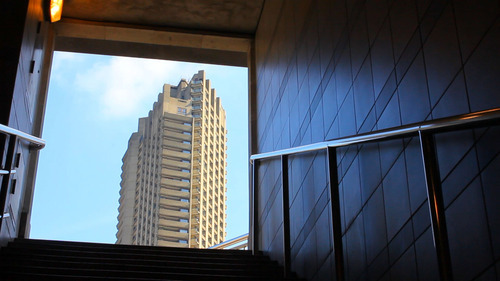
What inspired you to make this documentary?
I had seen some images on a few retro blogs and the idea of this lost vision made me incredibly excited and nostalgic. There wasn’t much information out there on the walkways and there were only a few photographs so this and the fact that no-one else had made anything on the subject that motivated me to get started. It turned out to be a perfect time to do it as a lot is now being demolished - so much has changed in the area since I began the film that my own contemporary footage is now archive.
What was the most interesting discovery about the Barbican you made while researching the film?
I don’t think I ever appreciated the craftsmanship in the stonework until I was shooting the estate and noticed how sculptured it was - the rough textured concrete was in fact, pick axed by hand. The word ‘brutalist’ is often used but it certainly doesn’t remind me of buildings like the Tricorn Centre, which I grew up being intimidated by on trips to Southsea. The Barbican is a true original.
Do you have a favourite spot in the Barbican Centre or Estate?
It has to be walking along Gilbert Bridge over the lake. I use this part quite often and it gets me every time. It’s a spot that really gives you an idea of not only the scale of the Barbican, but of the feeling you get from being at that elevated level. It’s especially beautiful in the summer and I always spend the short time whilst I’m walking over the bridge with my head panning from left to right. There’s so much to look at.
Where else in London would you recommend other city wanderers explore?
Anyone who hasn’t taken a stroll through the alleyways around the Bank and St Paul’s area should absolutely do so. Burgon Street, Wardrobe Terrace, St Michael’s Alley and Castle Court spring to mind, with well-maintained old shop facades, cute pubs and pretty churches. You can easily waste a few hours weaving through it all.
About Chris Bevan Lee
Having started out in the film and television industry, filmmaker Chris Bevan Lee made the move to advertising where he has worked on a number of large campaign projects - creating short documentaries for companies such as Land Rover, Nokia and Transport for London. The 2009 documentary Far from the Sodding Crowd was his first film that explored the unknown side of the UK and The Pedway: Elevating London continues the theme of the eccentric and cements Chris’s passion for factual storytelling.
VIsit: www.elevatinglondon.co.uk Follow: @ElevatingLondon
Read the article that inspired The Pedway: Elevating London, Michael Hebbert's The City of London Walkway Experiment
#Barbican Centre#Barbican Estate#Architecture#Chris Bevan Lee#Documentary#Film#London#Urban#Urban Wandering#Photography#Concrete
5 notes
·
View notes
Text
The Magic Makers
Tom Morris (artistic director of Bristol Old Vic), Adrian Kohler and Basil Jones (co-founders of Handspring Puppet Company) talk to Helen Babbs about life after War Horse and their new collaboration on A Midsummer Night’s Dream.
For director Tom Morris, the decision to work with puppets never felt like a radical one. Talking as he cycles to catch a train, he’s not just breathless with exertion but also with enthusiasm for the theatrical possibilities puppetry offers. It’s a passion he’s nursed for some time.

Working at Battersea Arts Centre (BAC) in the 1990s, Tom shared a building with the Puppet Centre, an organisation determined to get puppetry taken seriously. Their enthusiasm was infectious. During this period, Handspring Puppet Company came over from South Africa to perform at BAC, sealing Tom’s fate.
He later collaborated with them on War Horse, which has played to millions worldwide and is credited with sweeping puppetry firmly into the mainstream. As Tom says, ‘puppetry isn’t taboo any more’.
Shakespeare’s play is well suited to puppetry, dealing as it does with the tricks the imagination can play. According to Basil Jones, executive producer at Handspring, ‘everything is potentially alive’ in the production. ‘We slightly jokingly said everything has the right to life, so even floorboards can come alive.’
Hippolyta is imagined as a sculptress, crafting images of the spirits she hopes will bless her imminent marriage. These then come alive as puppets. ‘Out of the figures she makes, chaos erupts,’ explains Tom.
Handspring has created about thirty fantastical puppets for the play, made from wood and cane, and ranging in scale from tiny to giant. Oberon and Titania stand two and a half metres tall. Sometimes they’re used in bits – just a huge head and larger-than-life hand, say – and at other times they are presented as the complete figure.

‘The aesthetic of the play is a little bit future survivalist,’ explains Adrian Kohler, artistic director of Handspring. ‘There seems to have been some destructive force on the universe that these people live in. It’s a world where magic has possibly been reinvented, or brought back into the lives of the characters because they need it. The puppets are an embodiment of that language.’
Shakespeare’s audiences believed in supernatural forces and spirits, and with this production Tom wants you to as well. ‘The audience creates the life of the show. This is true of all theatre to a certain extent, but with puppetry nothing can happen unless the audience believes the puppets are alive.’
Expectations run high after War Horse, but the chance to revive their second show together feels like a privilege. The Barbican presented Handspring’s Woyzeck on the Highveld in 2011 and so it will be a welcome return for the company.
‘The show is a fluid entity, it’s a work that’s continually evolving,’ says Adrian. ‘The production at the Barbican is fortunate as we have the opportunity to refine it further. We hope people come with an open mind to how we’ve interpreted Shakespeare, rather than how we have rehashed War Horse.’
Helen Babbs is a writer and editor with a passion for theatre, especially puppetry.
Bristol Old Vic and Handspring Puppet Company’s A Midsummer Night’s Dream will be performed in the Theatre, 6–15 February 2014.
Photo: Simon Annand
Originally published in our February 2014 Guide.
#Barbican Centre#Theatre#Handspring Puppet Company#Shakespeare#Midsummer Nights Dream#Bristol Old Vic#Puppetry#War Horse
4 notes
·
View notes
Text
The Return of the RSC
Sarah Hemming learns why Richard II resonates with audiences today and reveals details of an exciting new partnership between the Barbican and the RSC.
‘It’s a dangerous play,’ says Gregory Doran, artistic director of the Royal Shakespeare Company. ‘People in power have always found it disconcerting, because they don’t like to see how power corrupts and how power fails.’

Doran is not talking about a tough piece of contemporary drama, but about Richard II, one of Shakespeare’s most lyrically beautiful plays, which the RSC brings to the Barbican in December, with David Tennant in the lead. Though it is known for its eloquent, elegiac descriptions of England, Doran suggests that the power struggle it depicts could not be more topical for today’s audiences.
Speaking during rehearsals, Doran adds that the production will retain medieval dress but that Tennant, with whom he is working again following a stunning RSC production of Hamlet in 2008, brings out the immediacy of a text.
‘What I love about David is that he has this complete inability to be anything other than contemporary. He makes the verse so accessible because he has such facility with it.’
The production marks a reunion in more ways than one. It celebrates the return of the RSC to the Barbican stage (originally designed as its London home from 1982) after the company left abruptly in 2002. This time the two institutions will work on a very different footing. The arrival of Richard II signals a new three-year collaboration, during which the RSC will transfer several major productions from Stratford-upon-Avon (Henry IV, Parts 1 and 2 will follow in 2014) and both organisations will collaborate closely on a creative learning programme to enhance the experience for audiences of all ages.

In recent years, the Barbican has combined outstanding international theatre productions with work from innovative and emerging artists, and has fostered an active, integrated creative learning strategy. It can offer readings, film screenings and workshops to complement the RSC’s work on stage.
‘We work with a number of international and British companies over time to really deepen those relationships,’ explains Toni Racklin, Head of Theatre at the Barbican. ‘This is an amazing opportunity to collaborate with the RSC whose work fits so perfectly into our programme.’
Doran feels that the RSC needs a London space it can commit to, rather than a year-round London home. For him, both the Barbican theatre itself and its creative infrastructure offer opportunities to plan a mutually fruitful partnership.
‘Since the RSC’s departure, the Barbican has redefined itself and become this fantastic international art house,’ he says. ‘It was wonderful to find such a welcoming response from the Barbican. We have to demonstrate that in coming back we want to make real, genuine collaboration work. And what is wonderful is to find such a welcoming response here.’
Originally published in our December 2013 Guide.
Royal Shakespeare Company, Richard II is performing 9 December 2013–25 January 2014.
Photo: Jake Mann, David Tennant, Marcus Grifiths and Sam Marks in rehearsal for Richard II © Kwame Lestrad
David Tennant, Gregory Doran, Nigel Lindsay © Kwame Lestrade
Sarah Hemming writes and broadcasts about theatre and is theatre critic for the Financial Times
#Barbican Theatre#Richard II#David Tennant#Shakespeare#Royal Shakespeare Company#Theatre#Performance#Interview
15 notes
·
View notes